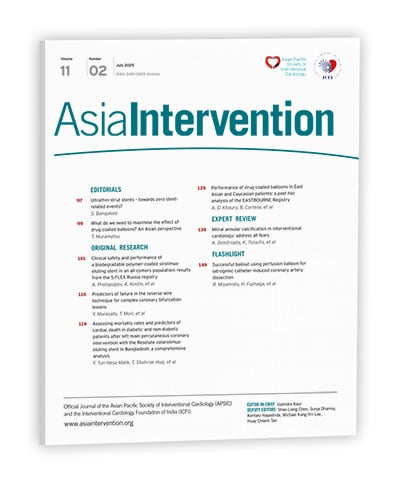Drug-coated balloon (DCB) technology has been developed as an alternative to the gold-standard drug-eluting stents (DES) in the treatment of obstructive coronary artery disease. In contrast to DES, where the antiproliferative drug coating is only on the surface of struts, DCBs can deliver the drug uniformly to the vessel wall without leaving anything behind. Paclitaxel and sirolimus are the two dominant regimens for the current DCB technologies; the former is a cytotoxic drug that has a narrow therapeutic range with better permeation and long retention in the tissue, and the latter is a cytostatic rapamycin that has a wide therapeutic range with slow transfer and short retention. Due to potential concerns regarding cytotoxicity and distal particle embolisation associated with paclitaxel, sirolimus DCBs have been recognised for their safety profiles. Nevertheless, the randomised TRANSFORM I trial suggested differential effects between the paclitaxel DCB (SeQuent Please Neo [B. Braun]) and the sirolimus DCB (MagicTouch [Concept Medical]). Specifically, the paclitaxel DCB showed a positive correlation, whereas the sirolimus DCB showed an inverse correlation, between the dissection volume assessed by optical coherence tomography and late luminal gain1. This finding was partially supported by an animal study demonstrating a greater loss of medial smooth muscle cells (SMCs) with paclitaxel DCBs compared to sirolimus DCBs2. Therefore, DCBs utilising rapamycin analogues need to figure out the optimal drug dosage and best coating technology in order to maximise their efficacy.
In this issue of AsiaIntervention, El Khoury et al report an interesting post hoc analysis of the all-comer EASTBOURNE Registry regarding the ethnicity of patients (i.e., Caucasians vs East Asians)3. These two ethnicities clearly showed different backgrounds and risks of repeat revascularisation or bleeding complications after angioplasty with the MagicTouch DCB. Crude data showed that all the individual components of the ischaemic endpoints (i.e., all-cause death, myocardial infarction and revascularisation) were significantly higher in Caucasians than East Asians, while bleeding events defined as Bleeding Academic Research Consortium 2, 3, or 5 were lower.
In cases with multiethnic clinical studies or investigational device exemption trials, we have to understand the so-called “East Asian paradox”, in which East Asians are generally more susceptible to bleeding complications than thrombotic events despite a higher prevalence of CYP2C19 gene mutation substantially affecting drug metabolism4.
It should also be noted that the rate of rescue bailout stenting after DCB treatment was significantly lower in East Asians (1.9%) than Caucasians (9.2%). Although these numbers seem smaller than the approximately 14% noted in the European BASKET-SMALL2 trial5, procedural factors (e.g., DCB without predilatation) might be associated with successful angioplasty with DCBs. There would no longer be any argument that lesion preparation is of prominent importance for the DCB strategy. Intracoronary imaging techniques may help in better understanding plaque characteristics and appropriate sizing of predilatation balloons. Predilatation with a conventional balloon is currently recommended in the majority of consensus documents worldwide, but the Japanese Association of Cardiovascular Intervention and Therapeutics (CVIT) recommends a modified (e.g., scoring or cutting) balloon for lesion preparation prior to DCB treatment6. The modified balloons are effective in achieving a larger lumen area even at a relatively low inflation pressure, and a recent animal study demonstrated that cutting balloon angioplasty prior to the paclitaxel DCB enhanced the drug effect, assessed as a loss of SMCs7. The ongoing NATURE trial will provide important insights with respect to the predilatation balloon, intracoronary imaging findings, and physiological assessment for successful angioplasty with DCBs8.
Finally, for patients who do not want to have a permanent implant of medical devices or for those with suspected metallic allergy, the “leave-nothing-behind” strategy sounds attractive to eliminate the nidus for long-term device-related complications. A possible reason for the more frequent DCB use in Asia than in Europe is that DCBs are less likely to necessitate long-term antithrombotic therapy for patients with high bleeding risk or to limit future therapeutic options compared to the standard DES. More importantly the “leave-nothing-behind” revascularisation by DCBs offers physiological cyclic strain, vasomotor response, and adaptive vessel remodelling. Thus, DCB angioplasty would work synergistically with the concomitant optimal medical therapy (e.g., lipid-lowering agents), which could reduce the amount of coronary plaque or stabilise the plaque vulnerability, ensuring favourable long-term clinical outcomes of patients undergoing DCB angioplasty.
Conflict of interest statement
T. Muramatsu has received honoraria from Abbott, Boston Scientific, Kaneka Medix, Shockwave Medical, Terumo, Daiichi Sankyo, and Novartis Pharma.

